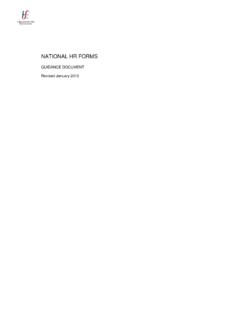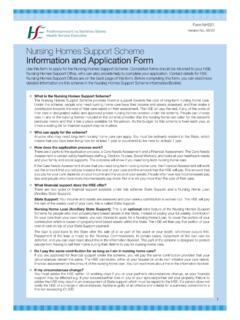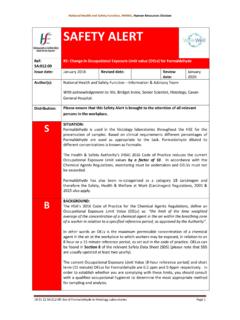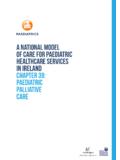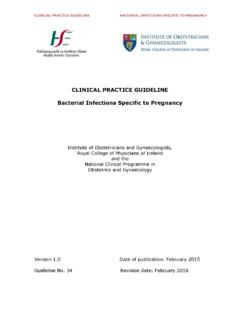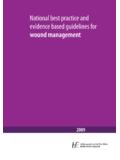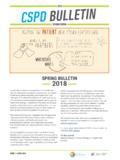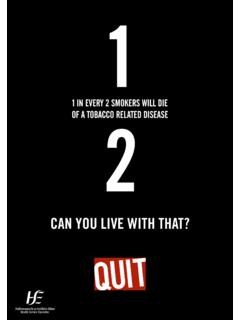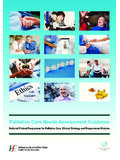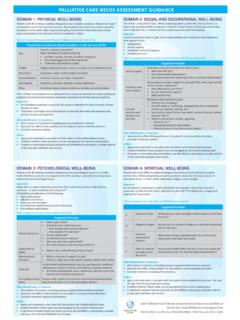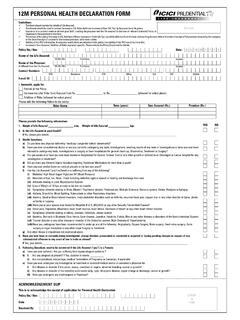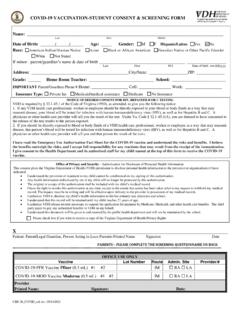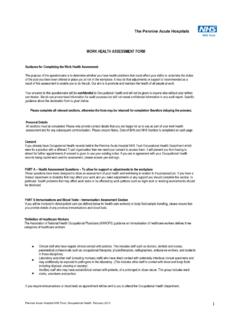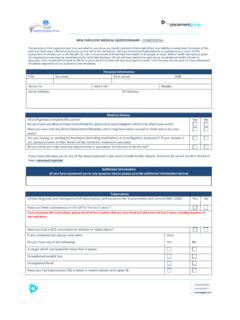Transcription of HC NIRF 01 V NIRF 01 PERSON
1 NATIONAL INCIDENT REPORT form (NIRF). HC NIRF 01 V12. Date issued: 26/11/2021. NIRF - 01 PERSON . NIMS record Number: Incident: An event or circumstance which could have, or did lead to unintended and / or unnecessary harm. Please complete this form to the best of your knowledge at the time of reporting the incident. SECTION A: GENERAL INCIDENT DETAILS SECTION B: PERSON AFFECTED DETAILS. Date of incident First name Time of incident Use 24 hour clock Surname Location Hospital, Health Centre, Residential Centre etc. Date of birth Ward, Clients home etc. Offsite? Female Male Specific Location Description of incident: Division (tick one only ) Who was involved ? (tick one only ). Acute Hospital Service user (Resident/Patient/Client) Go to section C. Social Care Staff member Go to section D. Health and Wellbeing Panel staff / Agency / Locum Go to section D. Primary Care Member of the public-Proceed to section F. Mental Health Volunteer Go to section D. Ambulance Service External Contractor Go to section E.
2 National Corporate Services (staff only) Work Placement / Trainee Go to section D. SECTION C: SERVICE USER DETAILS ONLY SECTION D: STAFF MEMBER / AGENCY / PANEL STAFF /. WORK PLACEMENT / VOLUNTEER DETAILS ONLY. Healthcare Record No Category of PERSON Lead Clinician Employee no. Date absence This incident involved (tick one only ) commenced (if known). Neonatal Specialties Date returned to work Paediatric Specialties (if known) Note: For employee incidents reportable to HSA that result in an absence from duty for more than three consecutive days, Adolescent Specialties excluding the day of the accident, the date absence commenced Lost days and the date employee returned to work should be recorded on Adult Specialties the NIMS. Older PERSON Specialties SECTION E: EXTERNAL CONTRACTOR DETAILS ONLY. Antenatal, Audiology, Incident Occurred under Radiotherapy, Intellectual Disability, Company Name (Service / Specialty) Psychology Company no. Page 1 of 7. SECTION F: WHAT WAS THE OUTCOME AT THE TIME OF THE INCIDENT?
3 Outcome Body Part Affected Near Miss Nearly given wrong drug No Injury Wrong drug given but no harm occurred Category 3. Injury not requiring first aid Injury or illness, requiring first aid Injury requiring medical treatment Category 2. Long-term disability / Incapacity (incl. psychosocial). Permanent Incapacity (incl. Psychosocial) Category 1 Arm, Spine, Lung, Other Physiological Death SECTION G: TYPE OF INJURY (tick one only ). Apgar score <5@ 1 min HIE Grade 2 - Hypoxic Ischaemic Nerve Injury - face 7@5mins &/or pH Encephalopathy Other unexpected deterioration Aspiration HIE Grade 3 - Hypoxic Ischaemic Stillbirth Birth Specific Injury Cerebral irritability / neonatal Encephalopathy Sub-galeal / sub-aponeurotic seizure Hypoglycaemia - severe haemorrhage (Baby). HIE - Hypoxic Ischaemic Kernicterus Unknown Encephalopathy with Hypoglycaemia Neonatal death Other HIE Grade 1 - Hypoxic Ischaemic Nerve Injury - brachial plexus (incl. Encephalopathy Erbs Palsy). Death Perineal tear Unknown Birth Specific Injury Hysterectomy (Perinatal) Post-Partum Haemorrhage Uterine rupture (Mother) Incontinence (faecal) Rhesus iso-immunisation Other Incontinence (urinary) Incontinence (faecal & urinary).
4 Excessive Bleeding Febrile non-haemolytic transfusion Non-immunological haemolysis Blood Specific Injury Fainting reaction Other Immunological haemolysis Asbestosis Hepatitis Unknown Cancer HIV Dermatitis Diagnosed Disease Acute Radiation Syndrome Brucellosis TB. Disorder or Cond. Narcolepsy/Cateplexy Legionnaires Pleural Plaques Other Clostridium Difficle Hepatitis VRE. Diagnosed Infection COVID-19 MRSA VRSA. CPE Norovirus Other ESBL Unknown Allergic Reaction (incl. anaphylaxis) Cut / Laceration / Graze / scratch Malaise / Nausea Brain Injury / Concussion Death Nerve injury / Loss of Function Burn / scald / corrosion Dental injury &/or loss Puncture / bite General Injuries Choking / asphyxia Deterioration Rash / irritation Circulatory / volume depletion Haemorrhage Unknown Circulatory / volume overload Blister Other Pain/Discomfort Hearing Impairment / loss Tinnitus Other Hearing / Sight Injury Sight Impairment / loss Unknown Cancer Infection Other Misdiagnosis Fracture Unknown Amputation Fracture Swelling / Inflammation Bruising Repetitive Strain Injury (RSI) Unknown Crushing Slipped / Prolapsed Disc Whiplash Dental Fracture / Tooth loss Sprain / Strain Other Musculoskeletal Dislocation Soft tissue injury / Soft Tissue P.
5 Ulcer Stage 1: Intact skin with non-blanchable redness over bony prominence P. Ulcer Stage 2: Part thickness dermis loss: blister/open ulcer/no slough P. Ulcer Stage 3: Full thickness tissue loss: +/- visible subcutaneous fat P. Ulcer Stage 4: Full thickness tissue loss/necrosis: exposed bone/tendon/muscle Additional / Further Surgery Loss of Wages / Income / Unknown Personal Loss Limb Deformity Business Organ Retention Defamation of Character Loss of Consortium Other Damage to organ / body part Loss of organ / body part Unexpected complication/. Surgery Specific Dental Damage / Loss Nerve injury / Loss of Function deterioration Injury Retained foreign object Inadequate anaesthesia Unknown Other Anxiety / Trauma Stress Worried Well Traumatic/Emotional PTSD Unknown Other HC NIRF-01 Page 2 of 7. SECTION H WHAT TYPE OF HAZARD DID THIS INCIDENT RELATE TO? (Tick one option from Steps 1, 2, 3 & 4). Step 1. Step 2. Step 3. Step 4. Diagnosis Type Care process Incomplete/inadequate: Diagnosis Assessment/Monitoring Communication Delayed Diagnosis Consent Misdiagnosis/Incorrect Diagnosis Tests/Investigations Test Interpretation Documentation Missed Diagnosis Equipment Unknown/other Lack of availability Not performed when indicated/Delayed Other adverse event/Patient safety incident Incomplete/inadequate: Care Stage of Care Care process Communication Management Community Assessment/Monitoring Consent Outpatient/ED Tests/Investigations Documentation Inpatient Treatment/Intervention Equipment Unknown/other Lack of availability Not performed when indicated/Delayed Pre-existing medical condition Retained foreign object Wrong body part/site/side Wrong patient Wrong process/treatment/procedure Other adverse event/Patient safety incident Stage of Care Incomplete/inadequate.
6 Care process Surgical/Medical Communication Procedures Pre Procedure Assessment/Monitoring Consent Intra Procedure Tests/Investigations Documentation Post Procedure Treatment/Intervention Equipment Unknown/other Name of Initial Procedure Lack of availability Not performed when indicated/Delayed cannulation, colonoscopy Retained foreign object Wrong body part/site/side Name of Subsequent Procedure ( if required return to theatre) Wrong patient Wrong process/treatment/procedure EUA, hysterectomy Other adverse event/Patient safety incident Clinical Care Delivery type Care process Adverse event: Labour/Delivery Cord Prolapse Caesarean Section (Elective) Assessment/Monitoring Caesarean Section (Emergency) Eclampsia Tests/Investigations Low Apgars/Cord PH. Instrumental Delivery (Forceps) Treatment/Intervention Instrumental Delivery (Vacuum/ Placental Abruption PPH. Ventuse/Kiwi). Shoulder Dystocia Instrumental Delivery (Multiple Uterine Rupture Instruments). Other Non Instrumental Delivery Adverse event requiring transfer/.
7 Return to theatre: Cord Prolapse Eclampsia Low Apgars/Cord PH. Placental Abruption PPH. Shoulder Dystocia Uterine Rupture Other Incomplete/inadequate: Communication Consent Documentation Equipment Unknown/other Lack of availability Not performed when indicated/Delayed Retained foreign object Wrong process/treatment/procedure HC NIRF-01 Page 3 of 7. SECTION H WHAT TYPE OF HAZARD DID THIS INCIDENT RELATE TO? (Tick one option from Steps 1, 2, 3 & 4). Step 1. Step 2. Step 3. Step 4. Route of administration Adverse Drug Reaction Oral Administration Contra-indicated Intravenous Monitoring Drug Interaction Sub Cutaneous Ordering / Supply / Transport Failure / Malfunction of equipment Preparation / Dispensing Incomplete / Inadequate Intra Muscular (Pharmacy) Not preformed when indicated /. Topical Prescribing delayed Rectal Medication Reconciliation Omitted/Delayed Dose Inhalation Storage Wrong Dose / Strength Other / Unknown Wrong Drug What medication was involved? Wrong Formulation / Route Wrong Frequency Medication One Wrong Label / Instructions Wrong Patient Medication Two Wrong Quantity / Duration Clinical Care Parenteral Communication / Consent Adverse Effect Enteral Prescribing / Requesting Incomplete / Inadequate Nutrition Special Diet Preparation / Dispensing Not performed when indicated / Delay General Diet Administration Wrong Consistency Other Storage Wrong Diet / Wrong Blood Product Documentation / Records Wrong Process / Treatment / Procedure Whole Blood Equipment Wrong Patient Red Cells Blood / Blood Supply / Ordering / Transport Lack of Availability Platelet (Apheresis).
8 Product Presentation / Packaging Wrong dispensing label / instructions Platelets (Pooled). Transfusing blood Inappropriate for task / Wrong device Other Other Other Diagnostic Exposure > intended X-ray Over Exposure Above Notifiable levels Checking Patient ID Wrong body part / side Below Notifiable levels Diagnostic procedure Dose to comforters / carers Radiology (DR) Clinical Details on Wrong Patient <1mSv & Nuclear Referral Inadvertent dose to foetus >1mSv Medicine (NM) Communication /. Total dose or Volume Variation <10%. Consent Dose (NM) or Volume Variation 10-20%. Documentation /. (1 fraction) >20%. Records Equipment Wrong Drug Performing procedure Wrong Dose Pregnancy Status Wrong Process / Treatment /. Radiotherapy Unknown Intervention Failure / Malfunction Inadvertent deterministic effects Exposure to Bite (Human). Exposure to Bite (Insect / Animal). Exposure to Bodily Fluids Bacteria Exposure to Ingestion/Food/Water Bio Hazards Biological Fungus / Mould Exposure to Needle Stick Hazards / Please specify, if known: Prion Exposure to Skin Contact Acquired Virus Inhalation/Airborne Infections Organism Unknown Equipment, Implements, Facilities, COVID-19; MRSA etc.
9 Sharps (Non Needle). Unknown Other HC NIRF-01 Page 4 of 7. SECTION H CNTD: WHAT TYPE OF HAZARD DID THIS INCIDENT RELATE TO? (Tick one option from Steps 1, 2 & 3). Step 1. Step 2. Step 3. Absconsion / Missing Attempted Suicide Banging Self Against Walls/Furniture/Surfaces Hitting Body/Slap/Punch Self incl. Scratching &. Picking Self-Injurious Intentional Inappropriate Eating Behaviour Unintentional Inappropriate Touching Self-Harm Stripping Clothes in Public Area Behavioural Hazards Suicide Throwing objects Other Aggressive towards inanimate object Violence, Harassment Discrimination/Prejudice/Racial and Aggression Intimidation / Threat By a Family Member / Relative Neglect By a Member of the Public Non-Compliant / Obstructive / Rude By a Peer / Student Direct Physical Assault Child Abuse By a Prisoner Physical Harassment By a Service User Sexual Assault / Abuse By a Staff Member Sexual Harassment Unintentional Aggressive Behaviour Bullying Adult Abuse Verbal Assault / Abuse Please specify name of instigator Verbal Harassment Other Unknown Pre Existing Medical Condition Inadequate supervision gen health / post op Obstruction / protruding object From Height Surface contaminants From Equipment / Furniture Rough terrain / irregular surface Same Level / Ground Slip / Trip / Fall Inappropriate equipment use On Stairs Failure / malfunction of equipment On Steps Horseplay Other Physical training / sport Weather Condition Inadequate Lighting / design Other Object / Tools (Non Sharps).
10 Non Mechanical Sharps (Non Needle) Human Use / Error Physical Hazards (Incl. PERSON / Animal) Other Obstruction / Protruding Object PERSON Physical Training / Sport Manual Handling Defective Equipment Ergonomics Other Unsafe / Inappropriate system (Incl. manual / people Patient Handling Unknown handling) Physical Intervention Task Catering equipment Load Door / Gate / Barrier Working Environment Mechanical Individual Capability Healthcare Equipment Components Lifting Equipment / Accessories Other Office / Business equipment Liquid / Food / Steam Temperature Hot Equipment / Utensils (Excluding Fire) Cold Atmosphere / Environment Fire Defective Equipment Human Use / Error Vibration Please Specify Unknown Electrical Unsafe System Noise Explosion Exposure Radiation Electrical Wiring / installation HC NIRF-01 Page 5 of 7. SECTION H CNTD: WHAT TYPE OF HAZARD DID THIS INCIDENT RELATE TO? (Tick one option from Steps 1, 2, & 3). Step 1. Step 2. Step 3. Animal Remedy Insecticide Arsenic Lead Asbestos Metallic Dust Acid / Alkaline Bleach Motor / Gear / Hydraulic Oil Agri Chemicals Cadmium Natural Gas Gas Carbon Dioxide Organic Dust Chemical Hazards Carbon Monoxide Paint / Paint Product Other Chemical Chemical Fertilizer Petrol Products Lack of Supervision Crystalline Silica Polish Unknown Particulates Detergent Radon Human / User Error Petroleum / Synthetic Diesel / Kerosene Rodenticide Unsafe System Disinfectant Soap Oil Based Products Drain / Oven Cleaner Sodium Hydroxide Sanitation / Cleaning Drugs Solvents Chemicals Fungicide Spent / Used Oil Product Toxic Metals Glue / Adhesive Sulphuric Acid Grease Wrong Patient Herbicide Other Hydrochloric Acid SECTION I: IMMEDIATE ACTIONS TAKEN (For entry on Incident Review screen on NIMS).
